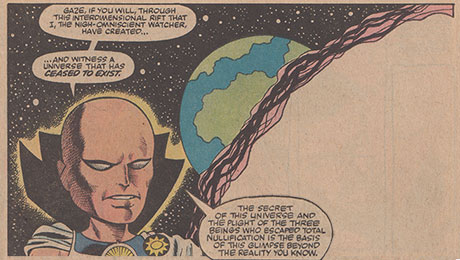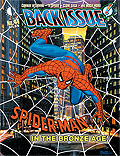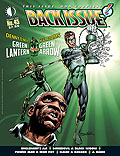Marvel: Heroes & Legends #1 (October 1996)
"For Better and For Worse"
Stan Lee/Fabian Nicieza-John Buscema/Sal Buscema/Gene Colan/Steve Ditko/Ron Frenz/John Romita, Sr./Marie Severin/Terry Austin/Al Milgrom/Tom Palmer/Bill Reinhold/Joe Sinnott
Doug: Just take a look at that cast of creators, and you'll easily see why this book is a favorite of mine! I'll admit right up front that the script here stinks for the most part. I think Stan was working way too hard to seem quaint -- really wanting a throwback to Marvel's Silver Age heyday. But, he was certainly handicapped from the get-go by a weak plot from Fabian Nicieza. This book was published in the years shortly after Marvels, when the House of Ideas had ceased to be new for the most part, and became bent on a program of recycling; hence you'll find Marvels narrator and protagonist Phil Sheldon alongside a youth -- the latter serves as the catalyst to bring all of the heroes into action. But what's lost here is the fact that Kurt Busiek told the tale of Marvels through Phil Sheldon. Here, Sheldon is a bystander who just happens to find himself in the thick of things. And the young lad who gets himself lost amid the throng of celebrity watchers on the day Reed Richards married Susan Storm? He's really a pain-in-the-butt and for my money would have been better left to the mercy of the Grey Gargoyle. Sheesh, but I'm curmudgeonly in this season of brotherly love!
Doug: So given that the basic premise of the story is that the kid is along a crowd-restraining barrier, freaks out when the super-scuffle breaks out and gets separated from his dad, and encounters all of Marvel's Silver Age stable (sans the Hulk and Dr. Strange) of characters before he's eventually reunited with his father, I thought I'd approach this review just a bit differently. I've included nine images from the story, the latter eight celebrating the artists of Marvel's past (with the exception of the final sample, which is by Ron Frenz).
Doug: Leading off, above, is Our Pal Sal Buscema. I chose this page, as well as all of those that follow by this simple criteria -- I felt these pages best represented the artists as we knew them. Look at the Sal offering -- action, emotion, and those undeniably Sal-like facial expressions. One comment -- I cannot stand when stories that are written from a past perspective use modern expressions in the script. Example A is Jonah telling Robbie, "Grab your cellular phone! Gotta call the Bugle!" Given that this is an "untold tale", I don't know why any such updating was necessary.
Doug: Next up is Sal's older brother, Big John Buscema. I know we sometimes use the term "stock pose", and one could certainly argue that the second panel is just that from the pencil of JB; but ain't it great?? Love it to pieces. In case you're wondering, the story segues from one artist to the other, sometimes on the same page, but sometimes at the top of a page. In the case of the brothers Buscema, they actually share a transitional page -- very appropriate, I felt.
Doug: Jazzy Johnny takes center stage next, and on his trademark character. This was a bit ironic to me, as on the cover credits you'll notice the name of Steve Ditko. But, given that there is no mention of Dr. Strange, I thought Ditko on Spidey would be a slam dunk. But no -- you'll have to scroll down just a bit to see where he wound up.
Doug: Yep, Ditko's on the Fantastic Four. A couple of things to remember -- Jack Kirby had passed away about two years prior to the publication of this mag. And, what's more, Ditko had only a smattering of experiences as the penciller on Fantastic Four stories. So I still believe that, while his inclusion in this book was a wonderful touch, his assignment to the FF portion is dubious at best. Romita could have done it, as he'd had that short stint following Kirby; but I think we'll all agree that Romita and Spider-Man are like peanut butter and jelly.
Doug: You know what I like about Gene Colan? His energy. From the panel lay-outs to the incredible sense of speed he instills to his characters in action, Colan is a vibrant storyteller. Below you'll find yourself some vintage Daredevil.
Doug: Of all the Silver Age greats included, I felt that Marie Severin's talents had declined the most. This is unmistakably her; you can even get a sense of the caricature work she did in Not Brand Echh! I'm at a loss to know if she ever did the art on the X-Men, but given the choices that were not available (Don Heck, Werner Roth, etc.), it's fine by me that the first lady of Marvel was included on the Merry Mutants.
Doug: I'm not sure what's going on with Ron Frenz in this book. Don't get me wrong -- I enjoyed his work on Amazing Spider-Man and the Silver Surfer revival. And I suppose for those consumers who were teens in 1996, a little injection of then-modernism may have been a selling point - search me. It's good stuff (although some of his faces are really off -- there's a panel of Sue that I didn't include where her eyes are closer to her ears than to her nose!)
Doug: I'm sure there are those among our readers who didn't even know this magazine existed. There's actually a second issue that features the Avengers, but I've never seen it so can neither pump nor pan it. Despite this story's poor writing, it still remains a fave of mine. I've long contended, contrary to the opinions of just about anyone who will listen, that art carries the comics medium over story. And I'll use this book as my support. At the end of the day, Stan failed me. But the heroes of my youth -- those guys and gal who gave me the best time copying their lines as if they were my own, returned one more time to make me smile. That's what comics in the '60's and '70's were all about, after all.
BONUS: How about one more page of John B. love? Several years ago I purchased a pencil rough from a dealer on Ebay. It happens to correspond to the published page below it. We've discussed recently how by the '80's and beyond Big John was largely doing breakdowns with his inkers given the responsibility of finishing and polishing. So marvel at this creative process, and get all giddy at the sight of a JB original.




























































14 comments:
This is a strange coincidence. There’s a guy on eBay selling the GS & Annuals of just about everything right now. I can never remember which FF’s I have because the numbering is just crazy: 1-3 are King Size Annuals, 4 -10 are King size Specials, 11-27 are back to annuals, and then like most Marvels, there are 5 GS issues, but they carry on the numbering from Giant Size Superstars, so you have GS Superstars #1, followed by GS FF 2-6. Then the Vol 2 annuals have years rather than numbers: 1998-2001. Don’t get me started on what’s new and what’s reprint or indeed which years which ones came out, let’s just say someone at Marvel needs to look up the word ‘annual’ in their Funk & Wagnall’s.
For that reason, I was leafing through Annual #3, the wedding of Reed & Sue, for the first time in over 30 years last night and thinking how great it was.
Doug, you’re right, I had no idea this existed. It looks wonderful. And to see so many of our old friends (characters & artists) in the same place is nirvana. I don’t agree about Sal...that page is unrecognisable to me as Sal Buscema. Not so Big John, which is instantly recognisable, as much for the layouts as the art itself. Romita, again, looks more post-Romita to me. The layouts look like John Byrne was leaning over his shoulder. Ditko is pure Ditko. So why was Doc Strange excluded? Or the Hulk? Colan is vintage. Instantly recognisable and I’m glad it was given to him rather than Miller. I can’t remember Marie Severin ever drawing Xmen interiors, but she did a load of covers at the very end of the original stories and a few of the reprint covers as well (although I’m sure we all immediately think Kane, right?).
As for JB love....well, check out Aragon in that picture. The only thing harder to draw than a horse must surely be a winged horse. Gotta love Big John.
Richard
First time I've heard of this, much less seen any pages. I'll take your word for it about the story, but I am loving the art you posted. In fact, I rather like the FF page by Ditko (wouldn't mind seeing more of it) as well as Severin's X-men page.
Blow Your Own Trumpet Dept: The cover to FF Annual #3 is featured on the inside front and back covers of this issue. You may be interested to know that 'twas myself who restored and re-created this cover, utilising a partial, poor-quality printing in a British comic from the '60s.
Hey Doug, great review. I own this book myself, and when I saw you were reviewing it I went and dug it out. I agree with you that the plot and scripting are not quite up to par with the awesome classic artwork.
Here are my own thoughts on the art in order of appearance.
I love Sal Buscema, but his art here looked pretty rough to me. It may have been the inker, which I believe was Tom Palmer, but I would not even have recognized this as Sal's work if he wasn't listed in the credits.
His brother, John Buscema, however hadn't lost a beat. His stuff looked fantastic. It really took me back to the good old days. It especially reminded me of one of my favorite books "How To Draw Comics The Marvel Way".
'Jazzy' John Romita did a stellar job as well recreating his classic rendition of Spider-Man. His version of Phil Sheldon looked kind of like Stan Lee with an eye patch. I wonder if that was intentional.
Which brings us to… Steve Ditko, who I (and everyone else) would have loved to see do Spider-Man one more time. But, as Ditko has said himself, there is NO WAY he would EVER draw the wall-crawler again, for any reason. I think if they offered him a million dollars he wouldn't render one webline. He is extremely bitter over what happened between Lee and himself concerning the web-head, and apparently the man can hold onto a grudge like no one else. As for his work on the Fantastic Four pages in this book, it was just O.K. at best. Ditko's quirky style never quite worked for the FF or the Avengers or really any other Marvel characters except Spider-Man and Doc Strange.
Gene Colan's Daredevil actually looked better to me than it used to when he originally drew the character. The art was clean, bold and dynamic. Colan's segment was definitely one of my favorite parts of this book. A real stand out.
Marie Severin, on the other hand, looked like she was drawing with her left hand (assuming she was right handed). Not to be too critical, but it looked like some of the comics I drew back in high school.
And lastly there's Ron Frenz. He was probably included because he can do a great imitation of Jack Kirby, although he wasn't really doing that here. I absolutely LOVE Ron Frenz's art. He is hands down my favorite Spider-Man artist (even over Ditko and the Romitas) and I thought it was nice that he was included on this project.
As you said, all-in-all this is a great little comic and should be a part of any Bronze Age Baby's collection. Excelsior!!!
I don't know if any of our readers are familiar with Sal's output in the mid-90's on Spectacular Spider-Man, but I found the page sample I used to be pretty indicative of his work on that book in this time. I agree that it's quite a departure from his Defenders and Hulk of the '70's, but I still find the facial expressions in the sample to be "Sal".
Doug
Glad to see this book reviewed; picked it up on a whim when it came out and then essentially forgot about it. It's rather fun to read it alongside the original story from FF Annual 3, comparing the expanded scenes to the originals.
Doug- that's a nice Buscema page you showed us! Original comic artwork is fasinating, whether a pencil rough or an actual page (complete with editing marks and blue pencil). You really get a chance to appreciate the artist's linework, seeing it full-size and unreproduced...and occasionally, you find changes made to a page before printing. Kind of like the deleted scenes on a blue-ray disc.
Hi William – sad & true about Ditko. If any of you get the chance there is a brilliant little documentary by a UK TV presenter called Jonathan Ross. Ross is a rabid comic fan, to the extent that one of his kid’s middle name is Kirby, and probably has the dream wife in BAB’er terms (young, former model, and the screenwriter of Stardust, X Men First Class and Kick Ass).
In 2007 Ross and a friend (Neil Gaiman) made a documentary called In Search of Steve Ditko, in which everyone (Stan, Romita, Alan Moore) talked about Ditko and at the end they interview the man himself. He refused to be filmed, but did give them an interview, the content of which they report.
Essential viewing for all BAB’ers, if you can find it somewhere.
http://en.wikipedia.org/wiki/In_Search_of_Steve_Ditko
Richard
I like Colan's page the best--offbeat, yet it still all balances out. Love seeing JB's sketches, roughs, and also Thor zooming in on the other finished page.
Perhaps Frenz was chosen as representing traditional Marvel style, when the Image style was taking over in the '90s?
Richard, I saw that Ross film about Ditko a few years ago, and while it was fascinating for the most part, the ending really, really annoyed me: instead of actually breaking through Ditko's moratorium on any media appearances and giving us exclusive footage of the man himself, we get Ross and Gaiman gushing at the end about their private meeting with him - like a pair of fanboys at a convention. I almost felt like they were rubbing it in our faces...
Correct me if I'm wrong, but didnt the Grey Gargoyle have a more educated "voice"??? I never remember him speaking like a thug (like the Wrecking Crew guys spoke).
I would think this group of creators would have picked up on that.
starfoxxx
I have to agree, the visuals are the main driving force in the comics. Stan Lee might tell you the opposite. Since he would have to give Kirby and Ditko a share of the millions Marvel made. I did have this book and enjoyed it a lot. It was good to see all that talent in one comic. I loved seeing John Romita work on Spider Man again. If you ask me, I was hoping this would be the start of a comic that would feature our favorites from the 70's on a more regular basis.
I love Steve Ditko's artwork on characters like Spider-Man, Doc Strange, The Creeper and Hawk & Dove, as well as his work at Charlton on Blue Beetle, Captain Atom, The Question and others.
But from all the things I've read about him, the man himself is one strange dude. From his unyielding, radical philosophical and political beliefs to his odd aversion to being photographed. What's up with that anyway? I thought the only people who were afraid of being photographed were superstitious natives, vampires and Nazi war criminals. I don't think that Mr. Ditko is any of those things (however I wouldn't totally rule out vampire). Hmm, maybe that's why he's so good at drawing weird scenes and supernatural characters.
Blake Bell's book "Strange & Stranger: The World of Steve Ditko" is a must-read for Ditko fans. William's info about Ditko refusing to revisit Spider-Man (or Dr. Strange) is 100% true. It's something he won't do, and when Ditko makes up his mind, that's the end of it.
As far as him not being photographed, it's not due to some type of superstition. Ditko is an intensely private person who doesn't want to be photographed, give interviews, speak at conventions, etc. Again, that's just how he rolls.
Here's another pencil page from this issue:
http://www.comicartfans.com/gallerypiece.asp?piece=848778
Do you have a scan of the finished page as inked by Terry Austin? I'd love to add it as an additional image in my gallery.
Pax,
Sean
Post a Comment